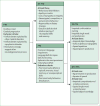Frontotemporal dementia
- PMID: 26595641
- PMCID: PMC5970949
- DOI: 10.1016/S0140-6736(15)00461-4
Frontotemporal dementia
Abstract
Frontotemporal dementia is an umbrella clinical term that encompasses a group of neurodegenerative diseases characterised by progressive deficits in behaviour, executive function, or language. Frontotemporal dementia is a common type of dementia, particularly in patients younger than 65 years. The disease can mimic many psychiatric disorders because of the prominent behavioural features. Various underlying neuropathological entities lead to the frontotemporal dementia clinical phenotype, all of which are characterised by the selective degeneration of the frontal and temporal cortices. Genetics is an important risk factor for frontotemporal dementia. Advances in clinical, imaging, and molecular characterisation have increased the accuracy of frontotemporal dementia diagnosis, thus allowing for the accurate differentiation of these syndromes from psychiatric disorders. As the understanding of the molecular basis for frontotemporal dementia improves, rational therapies are beginning to emerge.
Copyright © 2015 Elsevier Ltd. All rights reserved.
Conflict of interest statement
We declare no competing interests.
Figures



References
-
- Pick A. Über die Beziehungen der senilen Hirnatrophie zur Aphasie. Prager Med Wochenschr. 1892;17:165–67.
-
- Alzheimer A. Über eigenartige Krankheitsfälle der späteren Alters. Z Gesamte Neurol Psychiatr. 1911;4:356–85.
-
- Mesulam MM. Primary progressive aphasia. Ann Neurol. 2001;49:425–32. - PubMed
Publication types
MeSH terms
Grants and funding
LinkOut - more resources
Full Text Sources
Other Literature Sources
Research Materials

